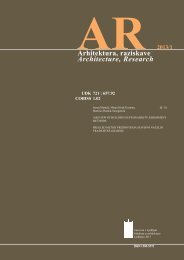Revija 2005/1 v PDF - Fakulteta za arhitekturo - Univerza v Ljubljani
Revija 2005/1 v PDF - Fakulteta za arhitekturo - Univerza v Ljubljani
Revija 2005/1 v PDF - Fakulteta za arhitekturo - Univerza v Ljubljani
You also want an ePaper? Increase the reach of your titles
YUMPU automatically turns print PDFs into web optimized ePapers that Google loves.
AR 2oo5 / 1Vojko Kilar, Toma SlakPRIMERJAVA OBNAŠANJA REGULARNIH INNEREGULARNIH KONSTRUKCIJ PRI POTRESNI OBREMENITVICOMPARISON OF THE BEHAVIOUR OF REGULAR AND IRREGULARSTRUCTURES UNDER EARTHQUAKE LOADSraziskava, researchpovzetekVrsta predpisov, <strong>za</strong>htev, smernic in priporoèil v predpisih ogradnji stavb na potresnih obmoèjih poudarja pomembnost tako vtlorisu kot v po višini èim bolj pravilnih (to ne pomeni nujnosimetriènih) konstrukcij stavb. Kot negativne se obravnavajo vsakeveèje prekinitve vertikalnih nosilnih elementov kot tudi vsakeveèje spremembe togosti v posameznih etaah. Ob pregledusodobnih konstrukcij stavb pa lahko ugotovimo, da se kreativnostsodobnega arhitekturnega izra<strong>za</strong> obièajno izogiba uporabipreprostih regularnih oblik in se rada <strong>za</strong>teka k oblikam, ki so skonstrukcijskega stališèa neregularne. Uporaba neregularnihkonstrukcij v predpisih sicer ni izrecno prepovedana, pomembnopa se je <strong>za</strong>vedati, da so takšne konstrukcije naèeloma draje, manjvarne in posledièno nekonkurenène.doseeni cilji, namen in rezultatiV predstavljeni raziskavi smo izbrali dva pri nas najobièajnejšakonstrukcijska sistema: a) AB okvir in b) AB stenasto konstrukcijoter pet najtipiènejših oblik neregularnosti: 1) nepravilnosti prirazporeditvi nosilnih elementov v tlorisu, 2) mehke etae, 3) kratkistebri, 4) neenakomerna razporeditev polnil in 5) razlièna nosilnostv dveh pravokotnih smereh. V predstavljeni fazi raziskave smo seomejili na elastièen dinamièen raèun èasovnega poteka odziva.Uporabljena akcelerograma sta si po maksimumih podobna, pofrekvenèni sestavi pa zelo razlièna. Prika<strong>za</strong>n je maksimalnihorizontalni pomik na vrhu konstrukcij, maksimalni relativnipomik ter maksimalni moment in preèna sila v stebru. Priprimerjavah je pomembna predvsem primerjava pomikov medrazliènimi nepravilnostmi pri isti obtebi in pri istemkonstrukcijskem sistemu, saj so dobljene razlike posledicaneregularne <strong>za</strong>snove, ki je predmet raziskave. Raèunalniškesimulacije so poka<strong>za</strong>le, da nepravilnosti in skoki v togostipovzroèajo poveèanje napetosti in neugodnih strinih ali torzijskihobremenitev. Še posebej je to nevarno kadar takšne napetostinastanejo v stebrih nijih nadstropij ali kadar se vzpostavi lokalniporušni mehanizem. Èetudi elementom, v katerih je prišlo doprekoraèitev napetosti, lahko poveèamo dimenzije in jih moènejearmiramo, so to še vedno mesta v konstrukciji, kjer bo v primerumoènega potresnega sunka lahko prišlo do hujših poškodb.problematika v arhitekturi, umestitevobravnavane teme v te tokove in njen pomenNeregularnim konstrukcijam se je potrebno izogibati e v fazi<strong>za</strong>snove konstrukcije, saj so takšne stavbe draje in potresno manjvarne. V prid arhitektom-projektantom lahko reèemo le, da vnekaterih primerih vplivi moèno neregularnih <strong>za</strong>snov niso biliprièakovano veliki. Moèno so lahko razlièni pri razliènih potresih zistim pospeškom tal in razlièno prevladujoèo frekvenco. Nalogapotrjuje tezo, da je regularna <strong>za</strong>snova konstrukcij in t. i. "potresnoodporna" gradnja po novih evropskih predpisih EC 8 ob ustreznemsodelovanju arhitekta in gradbenika pri <strong>za</strong>snovi objektov dobra<strong>za</strong>šèita pred posledicami moènih potresov.kljuène besedeZasnova konstrukcij, pravilnost, regularnost, potresno varnagradnja, arhitektura konstrukcij, Eurocode 8.summaryVarious regulations, demands, guidelines andrecommendations stipulated in building legislature forconstruction in earthquake prone areas state the importance ofregular building structures, both in layout and heights (whichdoesn't mean they are necessarily symmetrical). All largerdiscontinuity of vertical load-bearing elements, just as anysignificant changes in rigidity of particular floors, is seen asnegative. Upon a review of contemporary building structures wecan nevertheless establish that creativity in contemporaryarchitectural expression usually refrains from using simple regularforms and likes to take recluse in forms, which are, from thestructural attitude, irregular. Use of irregular structures is notstrictly prohibited in regulations, but we have to be aware that suchstructures are in principal more expensive, less safe andconsequentially less competitive.intentions, goals and resultsIn the presented research we chose two of the most oftenstructural systems used domestically: a) reinforced concrete frameand b) reinforced concrete wall structure and five of the mosttypical forms of irregularity: 1) irregularity in placement of loadbearingelements in the layout, 2) soft floors, 3) short columns, 4)unequal distribution of fillers and 5) different load-bearingcapacities in two perpendicular directions. In the presented phaseof the research we limited ourselves to elasticity calculation of timeprogression of response. The used acceleration graphs are similarin maximum values, while their frequency structures are verydifferent. The maximal horizontal shift at the top of structures,maximal relative shift, and maximal momentum and maximaltraverse force in columns, are shown. In comparisons, above allcomparison of shifts between different irregularities under thesame load and the same structural systems is important, since theobtained differences are consequences of irregular concepts, whichis the research issue at hand. Computer simulations showed thatirregularities, discontinuance and inconsistent rigidity causeincrease in tension and unbeneficial shearing or torsion loads inparticular elements of the structure. This is especially dangerouswhen these tensions emerge in columns of lower floors or whenlocal collapse mechanisms are established. Even if we increase thedimensions and add more reinforcement to elements, in whichtensions are excessive, these are still the places in a structure,where a stronger earthquake surge could cause serious damage.architectural issues, positioning the topicin ongoing debate and its’ significanceIrregular structures have to be avoided in early phases of thestructural design, since such buildings are more expensive and lessearthquake safe. For the benefit of architects-designers we can saythat in some cases the effects of irregular concepts weren't as bad asexpected. They can be very different under different earthquakeswith the same ground acceleration and different prevailingfrequency. The research proves the hypothesis that regularstructural concepts and so called "earthquake resistant" building,according to the new European regulation EC8, can provide goodprotection before consequences of strong earthquakes, if thearchitect and engineer cooperate adequately.key wordsstructural concept, correctness, regularity, earthquake-safeconstruction, construction architecture, Eurocode 8.69
















